How Data Analytics Can Improve the Financial Performance of Your Billing Clients
The healthcare industry is rapidly moving into a value-focused era. Your clients are constantly searching for ways to improve healthcare delivery and outcomes while growing their practices’ bottom lines.
The healthcare industry is rapidly moving into a value-focused era. Your clients are constantly searching for ways to improve healthcare delivery and outcomes while growing their practices’ bottom lines.
By Tolu Ajiboye
Contributor, Kareo
To stay ahead of the game, a billing company must offer more than just bare-bones billing services. You must be invested in improving the performance of your clients’ practices.
One of the most significant and impactful ways to do that is by providing and sharing data that can strategically help your clients make more informed business decisions for their practices’ growth. By firmly positioning data analytics alongside your billing operations, you show your commitment to the success of your clients’ practices.
One of the most significant and impactful ways to do that is by providing and sharing data that can strategically help your clients make more informed business decisions for their practices’ growth. By firmly positioning data analytics alongside your billing operations, you show your commitment to the success of your clients’ practices.
With the right data analytics software, you can pull multiple data types for your clients including:
- volume of encounters
- distribution of encounters
- appointments
- payer mix
- billing trends like charges, payments and adjustments
- A/R aging by payer scenario, insurance, or patient
- and key revenue indicators like claim rejection/denial rate and net collection rate
Here are some of the tangible ways that data analytics can improve the performance of your billing clients:
- Improve revenue cycle. Having access to key revenue indicators like claim rejections, denial rates and net collection rates can help you identify areas in your client’s overall billing and coding practices that can be improved upon. This data can also inform staff training and education on how to avoid commonly committed billing errors.
- Identify weaknesses. With data analytics, you can detect areas where the practice is falling short and collaborate with leadership to design strategies that will solve those issues.
- Set targets. By identifying the areas that can be improved upon, and having accurate metrics by which to measure them, you can help your clients set practical targets.
- Assess performance. This is perhaps the most evident use of data analytics in improving practice performance. You can obtain a holistic view of your billing clients’ performance. Indicators like total revenue and payer mix will give you a clear picture of the financial health of the practice. You’re also able to evaluate if goals are being achieved and targets are being met. Assessments like this can be done at regular intervals— monthly, quarterly or annually.
- Identify opportunities for growth and expansion. Data analytics lets you spot areas that might indicate growth opportunities. For instance, being able to view the distribution of encounters can help you identify conditions or treatments that are more popular with patients. This gives your clients the ability to make data-driven decisions (essentially more reliable and risk proof decisions) when making business expansion moves.
- Troubleshoot urgent issues. You can pinpoint issues like Denied or No Response claims that need to be addressed quickly to maintain positive cash flow. The right data analytics software will also let you detect payment delays, and what’s causing them.
- Free up time. As the biller, you have access to a centralized and accurate source of your clients’ revenue data. And by undertaking the task of data collection and analysis, you’re freeing up valuable time for your clients—that they would otherwise have spent trying to collate data.
Final tips on incorporating data analytics into your processes
- As a billing company, utilizing data analytics is crucial. The success of your clients’ practices directly translates to the success of your business.
- Establish a culture of data consultation and performance measurement. You and all your staff should use of data values for decision support into your workflows. Measuring the performance of your clients’ practices shouldn’t be an afterthought. Instead, it should make up one of your core processes.
- Set up regular meetings or brainstorming sessions to engage with your clients individually on their data and discuss how their data can be used to predict trends, improve on areas of under performance and continuously measure the performance of the practice.
Encourage your staff to use visualization to make data easier to assess and understand. Make it routine to include graphical elements like charts, graphs, and gauges in your reports for clients.
Not all data analytics software is built the same— some have more functionality than others. Also, overall, data analytics is a more powerful tool when it is integrated with the EHR of healthcare practices.
ABOUT KAREO
We believe in independent practices
We’ve chosen to focus on independent practices because we believe in what you do. We share the vision that independent practices are the best place for building relationships with patients and providing the most meaningful care. In fact, we believe that this is why people become health care providers in the first place.
FEATURED ARTICLES
Integrative Medicine: The Future of Medicine.
Integrative Medicine: The Future of Healthcare. The National Foundation for Integrative Medicine Peter Demitry, MD, MPH


